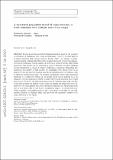Files in this item
A structured population model of clonal selection in acute leukemias with multiple maturation stages
Item metadata
| dc.contributor.author | Lorenzi, Tommaso | |
| dc.contributor.author | Marciniak-Czochra, Anna | |
| dc.contributor.author | Stiehl, Thomas | |
| dc.date.accessioned | 2020-07-25T23:37:01Z | |
| dc.date.available | 2020-07-25T23:37:01Z | |
| dc.date.issued | 2019-07-26 | |
| dc.identifier | 259622400 | |
| dc.identifier | 3687a6af-f788-4a38-a346-70cde88aa281 | |
| dc.identifier | 85069695251 | |
| dc.identifier | 000491549200001 | |
| dc.identifier.citation | Lorenzi , T , Marciniak-Czochra , A & Stiehl , T 2019 , ' A structured population model of clonal selection in acute leukemias with multiple maturation stages ' , Journal of Mathematical Biology , vol. First Online . https://doi.org/10.1007/s00285-019-01404-w | en |
| dc.identifier.issn | 0303-6812 | |
| dc.identifier.other | ArXiv: http://arxiv.org/abs/1907.02842v1 | |
| dc.identifier.uri | https://hdl.handle.net/10023/20338 | |
| dc.description | Funding: TS and AM-C were supported by research funding from the German Research Foundation DFG (SFB 873; subproject B08). TL gratefully acknowledges support from the Heidelberg Graduate School (HGS). | en |
| dc.description.abstract | Recent progress in genetic techniques has shed light on the complex co-evolution of malignant cell clones in leukemias. However, several aspects of clonal selection still remain unclear. In this paper, we present a multi-compartmental continuously structured population model of selection dynamics in acute leukemias, which consists of a system of coupled integro-differential equations. Our model can be analysed in a more efficient way than classical models formulated in terms of ordinary differential equations. Exploiting the analytical tractability of this model, we investigate how clonal selection is shaped by the self-renewal fraction and the proliferation rate of leukemic cells at different maturation stages. We integrate analytical results with numerical solutions of a calibrated version of the model based on real patient data. In summary, our mathematical results formalise the biological notion that clonal selection is driven by the self-renewal fraction of leukemic stem cells and the clones that possess the highest value of this parameter are ultimately selected. Moreover, we demonstrate that the self-renewal fraction and the proliferation rate of non-stem cells do not have a substantial impact on clonal selection. Taken together, our results indicate that interclonal variability in the self-renewal fraction of leukemic stem cells provides the necessary substrate for clonal selection to act upon. | |
| dc.format.extent | 35 | |
| dc.format.extent | 3062220 | |
| dc.language.iso | eng | |
| dc.relation.ispartof | Journal of Mathematical Biology | en |
| dc.subject | Acute Leukemia | en |
| dc.subject | Clonal selection | en |
| dc.subject | Continuously structured population models | en |
| dc.subject | Integro-differential equations | en |
| dc.subject | Asymptotic analysis | en |
| dc.subject | QA Mathematics | en |
| dc.subject | QH301 Biology | en |
| dc.subject | RC0254 Neoplasms. Tumors. Oncology (including Cancer) | en |
| dc.subject | T-DAS | en |
| dc.subject | SDG 3 - Good Health and Well-being | en |
| dc.subject.lcc | QA | en |
| dc.subject.lcc | QH301 | en |
| dc.subject.lcc | RC0254 | en |
| dc.title | A structured population model of clonal selection in acute leukemias with multiple maturation stages | en |
| dc.type | Journal article | en |
| dc.contributor.institution | University of St Andrews. Applied Mathematics | en |
| dc.identifier.doi | https://doi.org/10.1007/s00285-019-01404-w | |
| dc.description.status | Peer reviewed | en |
| dc.date.embargoedUntil | 2020-07-26 |
This item appears in the following Collection(s)
Items in the St Andrews Research Repository are protected by copyright, with all rights reserved, unless otherwise indicated.

